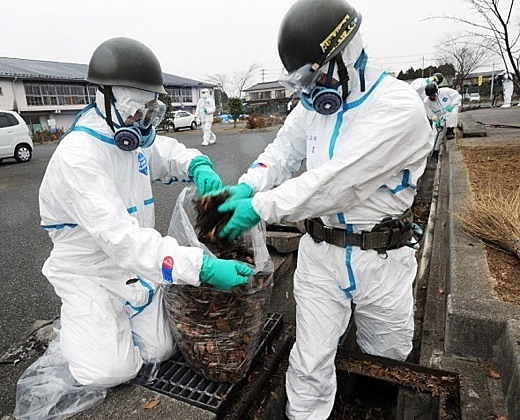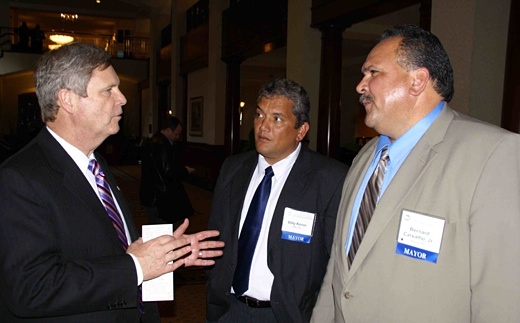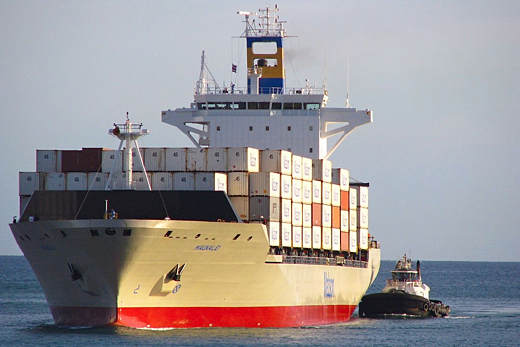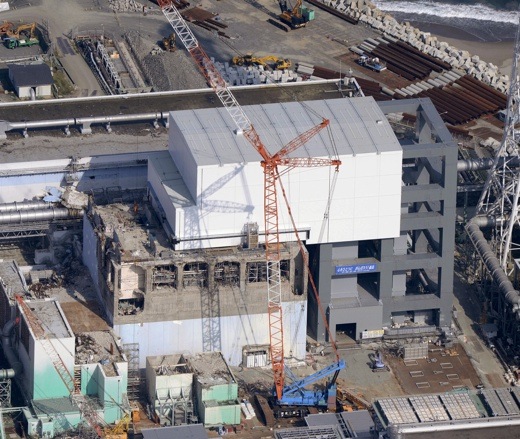SUBHEAD: But there may be others, who still have some fight left in them, and who do wish to leave a survivable planet to their children.
I admit it: in my last book, The Five Stages of Collapse, I viewed collapse through rose-colored glasses. But I feel that I should be forgiven for this; it is human nature to try to be optimistic no matter what. Also, as an engineer, I am always looking for solutions to problems. And so I almost subconsciously crafted a scenario where industrial civilization fades away quickly enough to save what's left of the natural realm, allowing some remnant of humanity to make a fresh start.
Ideally, it would start of with a global financial collapse triggered by a catastrophic loss of confidence in the tools of globalized finance. That would swiftly morph into commercial collapse, caused by global supply chain disruption and cross-contagion.
As business activity grinds to a halt and tax revenues dwindle to zero, political collapse wipes most large-scale political entities off the map, allowing small groups of people to revert to various forms of anarchic, autonomous self-governance. Those groups that have sufficient social cohesion, direct access to natural resources, and enough cultural wealth (in the form of face-to-face relationships and oral traditions) would survive while the rest swiftly perish.
Of course, there are problems even with this scenario. Take, for instance, the problem of Global Dimming. The phenomenon is well understood: sunlight reflected back into space by the atmospheric aerosols and particulates generated by burning fossil fuels reduces the average global temperature by well over a degree Celsius.
The cessation of all air traffic over the continental US in the wake of the terrorist attacks of 9/11 has allowed climate scientists to measure this effect. If industrial activity were to suddenly cease, average global temperatures would be jolted upward toward the two degree Celsius mark which is widely considered to be very, very bad indeed. Secondly, even if all industrial activity were to cease tomorrow, global warming, 95% of which is attributed to human activity in the latest (rather conservative and cautious) IPCC report, would continue apace for the better part of the next millennium, eventually putting the Earth's climate in a mode unprecedented during all of human existence as a species.
On such a planet, where the equatorial ocean is hotter than a hot tub and alligators thrive in the high Arctic, our survival as a species is far from assured. Still, let's look at things optimistically. We are an adaptable lot. Yes, the seas will rise and inundate the coastal areas which over half of us currently inhabit. Yes, farmland further inland will become parched and blow away, or be washed away by the periodic torrential rains.
Yes, the tropics, followed by the temperate latitudes, become so hot that everyone living there will succumb of heat stroke. But if this process takes a few centuries, then some of the surviving bands and tribes might find a way to migrate further north and learn to survive there by eking out some sort of existence in balance with what remains of the ecosystem.
We can catch glimpses of what such survival might look like by reading history. When Captain James Cook landed on the shore of Western Australia, he was the first white man to encounter aboriginal Australians, who had up to that point persisted in perfect isolation for something like 40.000 years.
They arrived in Australia at about the same time as the Cromagnons displaced the Neanderthals in Europe.) They spoke a myriad different languages and dialects, having no opportunity and no use for any sort of unity. They wore no clothes and used tiny makeshift huts for shelter. They had few tools beyond a digging stick for finding edible roots and a gig for catching fish. They had no hoards or stockpiles, and did not keep even the most basic supplies from one day to the next. They had little regard for material objects of any sort, were not interested in trade, and while they accepted clothes and other items they were given as presents, they threw them away as soon as Cook and his crew were out of sight.
They were, Cook noted in his journal, entirely inoffensive. But a few actions of Cook's men did enrage them. They were scandalized by the sight of birds being caught and placed in cages, and demanded their immediate release. Imprisoning anyone, animal or person, was to them taboo. They were even more incensed when they saw Cook's men catch not just one, but several turtles. Turtles are slow-breeding, and it is easy to wipe out their local population by indiscriminate poaching, which is why they only allowed the turtles to be taken one at a time, and only by a specially designated person who bore responsibility for the turtles' welfare.
Cook thought them primitive, but he was ignorant of their situation. Knowing what we know, they seem quite advanced. Living on a huge but arid and mostly barren island with few native agriculturally useful plants and no domesticable animals, they understood that their survival was strictly by the grace of the surrounding natural realm. To them, the birds and the turtles were more important than they were, because these animals could survive without them, but they could not survive without these animals.
Speaking of being primitive, here is an example of cultural primitivism writ large. At the Age of Limits conference earlier this year, at one point the discussion turned to the question of why the natural realm is worth preserving even at the cost of human life. (For instance, is it OK to go around shooting poachers in national parks even if it means that their families starve to death?) One fellow, who rather self-importantly reclined in a chaise lounge directly in front of the podium, stated his opinion roughly as follows: “It is worth sacrificing every single animal out there in order to save even a single human life!” It took my breath away. This thought is so primitive that my brain spontaneously shut down every time I tried to formulate a response to it. After struggling with it for a bit, here is what I came up with.
Is it worth destroying the whole car for the sake of saving the steering wheel? What use is a steering wheel without a car? Well, I suppose, if you are particularly daft or juvenile, you can use it to pretend that you still have a car, running around with it and making “vroom-vroom!” noises... Let's look at this question from an economic perspective, which is skewed by the fact that economists tend view the natural realm in terms of its economic value.
This is similar to you looking at your own body in terms of its nutritional content, and whether it would make good eating. Even when viewed from this rather bizarre perspective that treats our one and only living planet as a storehouse of commodities to be plundered, it turns out that most of our economic “wealth” is made possible by “ecosystem services” which are provided free of charge.
These include water clean enough to drink, air clean enough to breathe, a temperature-controlled environment that is neither too cold nor too hot for human survival across much of the planet, forests that purify and humidify the air and moderate surface temperatures, ocean currents that moderate climate extremes making it possible to practice agriculture, oceans (formerly) full of fish, predators that keep pest populations from exploding and so on. If we were forced to provide these same services on a commercial basis, we'd be instantly bankrupt, and then, in short order, extinct.
The big problem with us living on other planets is not that it's physically impossible—though it may be—it's that there is no way we could afford it. If we take natural wealth into account when looking at economic activity, it turns out that we consistently destroy much more wealth than we create: the economy is mostly a negative-sum game.
Next, it turns out that we don't really understand how these “ecosystem services” are maintained, beyond realizing that it's all very complicated and highly interconnected in surprising and unexpected ways. Thus, the good fellow at the conference who was willing to sacrifice all other species for the sake of his own could never be quite sure that the species he is willing to sacrifice doesn't include his own.
In addition, it bears remembering that we are, in fact, sacrificing our species, and have been for centuries, for the sake of something we call “progress.” Aforementioned Captain Cook sailed around the Pacific “discovering” islands that the Polynesians had discovered many centuries earlier, his randy, drunken, greedy sailors spreading venereal disease, alcoholism and corruption, and leaving ruin in their wake wherever they went. After the plague of sailors came the plague of missionaries, who made topless Tahitian women wear “Mother Hubbards” and tried to outlaw fornication.
The Tahitians, being a sexually advanced culture, had a few dozen different terms for fornication, relating to a variety of sex acts. Thus the missionaries had a problem: banning any one sex act wouldn't have made much of a dent, while a ban that enumerated them all would read like the Kama Sutra. Instead the missionaries chose to promote their own brand of sex: the “missionary position,” which is best analyzed as two positions—top and bottom. The bottom position can enhance the experience by taking a cold shower, applying blue lipstick and not breathing. I doubt that it caught on much on Tahiti.
The Tahitians seem to have persevered, but many other tribes and cultures simply perished, or continue to exist in greatly diminished numbers, so depressed by their circumstances that they are not interested in doing much beyond drinking beer, smoking cigarettes and watching television. And which group is doing the best? That's the one that's been causing the most damage. Thus, the rhetoric about “saving our species from extinction” seems rather misplaced: we have been doing everything we can to drive it to extinction as efficiently as possible for a few centuries now, and we aren't about to stop because that would be uncivilized.
Because, you see, that's who we are: we are educated, literate, civilized persons. The readers of this blog especially are economically and environmentally enlightened types, their progressivism resting on the three pillars of pointing out financial Ponzi schemes, averting environmental devastation and eating delicious, organic, locally grown food. We do wish to survive collapse, provided the survival strategy includes such items as gender equality, multiculturalism, LGBT-friendiness and nonviolence.
We do not wish to take off all of our clothes and wander the outback with a digging stick looking for edible tubers. We'd rather sit around discussing green technology over a glass of craft-brewed beer (local, of course) perhaps digressing once in a while to consider the obscure yet erudite opinions of one Pederasmus of Ülm on the endless, glorious ebb and flow of human history.
We don't want to change who we are in order to live in harmony with nature; we want nature to live in harmony with us while we remain who we are. In the meantime, we are continuing to wage war on the sorry remnants of the tribes that had once lived in balance with nature, offering them “education,” “economic development” and a chance to play a minor role in our ruinous, negative-sum economic games.
Given such options, their oft-observed propensity to do nothing and stay drunk seems like a perfectly rational choice. It minimizes the damage. But the damage may already have been done. I will present just two examples of it, but if you don't like them, there are plenty of others.
For the first, you can do your own research. Buy yourself an airline ticket to a tropical paradise of your choice and check into an oceanside resort. Wake up early in the morning and go look at the beach. You will see lots of dark-skinned people with wheelbarrows, buckets, shovels and rakes scraping up the debris that the surf deposited during the night, to make the beach look clean, safe and presentable for the tourists.
Now walk along the beach and beyond the cluster of resorts and hotels, where it isn't being continuously raked clean. You will find that it is so smothered with debris as to make it nearly impassable. There will be some material of natural origin—driftwood and seaweed—but the majority of the debris will be composed of plastic. If you try to sort through it, you will find that a lot of it is composed of polypropylene and nylon mesh and rope and styrofoam floats from the fishing industry.
Another large category will consist of single-use containers: suntan lotion and shampoo bottles, detergent bottles, water bottles, fast food containers and so on. Typhoons and hurricanes have an interesting organizing effect on plastic debris, and you will find piles of motor oil jugs next to piles of plastic utensils next to piles of water bottles, as if someone actually bothered to sort them. On a beach near Tulum in México I once found an entire collection of plastic baby sandals, all of different colors, styles and vintages.
Left on the beach, the plastic trash photo-degrades over time, becoming discolored and brittle, and breaking down into smaller and smaller pieces. The final result of this process is a microscopic plastic scum, which can persist in the environment for centuries. It plays havoc with the ecosystem, because a wide variety of animals mistake the plastic particles for food and swallow them. They then clog their digestive tracts, causing them to starve. This devastation will persist for many centuries, but it has started already:
the ocean is dying. Over large areas of it, plastic particles outnumber plankton, which forms the basis of the oceanic food chain.
The ravages of the plastics plague also affect land. Scraped together by sanitation crews, plastic debris is usually burned, because recycling it would be far too expensive. Plastic can be incinerated relatively safely and cleanly, but this requires extremely high temperatures, and can only be done at specialized facilities.
Power plants can burn plastic as fuel, but plastic trash is a diffuse energy source, takes up a lot of space and the energy and labor costs of transporting it to power plants may render it energy-negative. And so a lot of plastic trash is burned in open pits, at low temperatures, releasing into the atmosphere a wide assortment of toxic chemicals, including ones that affect the hormonal systems of animals.
Effects include genital abnormalities, sterility and obesity. Obesity has now reached epidemic proportions in many parts of the world, affecting not just the humans but other species as well. Here, then, is our future: chemical plants continue to churn out synthetic materials, most of these find their way into the environment and slowly break down, releasing their payload of toxins. As this happens, people and animals alike turn into obese, sexless blobs. First they find that they are unable to give birth to fertile male offspring.
This is already happening: human sperm counts are dropping throughout the developed world. Next, they will be unable to give birth to normal male babies—ones without genital abnormalities. Next, they will be unable to produce male offspring at all, as has already happened to a number of marine species. Then they go extinct.
Note that no disaster or accident is required in order for this scenario to unfold, just more business as usual. Every time you buy a bottle of shampoo or a bottle of water, or a sandwich that comes wrapped in plastic or sealed in a vinyl box, you help it unfold a little bit further. All it takes is for the petrochemical industry (which provides the feedstocks—oil and natural gas, mostly) and the chemical plants that process them into plastics, to continue functioning normally. We don't know whether the amount of plastics, and associated toxins, now present in the environment, is already sufficient to bring about our eventual extinction.
But we certainly don't want to give up on synthetic chemistry and go back to a pre-1950s materials science, because that, you see, would be bad for business. Now, you probably don't want to go extinct, but if you decided that you will anyway, you would probably want to remain comfortable and civilized down to the very end. And life without modern synthetics would be uncomfortable. We want those plastic-lined diapers, for the young and the old!
This leaves those of us who are survival-minded, on an abstract, impersonal level, wishing for the global financial, commercial and political collapse to occur sooner rather than later. Our best case scenario would go something like this: a massive loss of confidence and panic in the financial markets grips the planet over the course of a single day, pancaking all the debt pyramids and halting credit creation. Commerce stops abruptly because cargos cannot be financed.
In a matter of weeks, global supply chains break down. In a matter of months, commercial activity grinds to a halt and tax revenues dwindle to zero, rendering governments everywhere irrelevant. In a matter of years, the remaining few survivors become as Captain Cook saw the aboriginal Australians: almost entirely inoffensive.
One of the first victims of collapse would be the energy companies, which are among some of the most capital-intensive enterprises. Next in line are the chemical companies that manufacture plastics and other synthetic organic chemicals and materials: as their petrochemical feedstocks become unavailable, they are forced to halt production. If we are lucky, the amount of plastic that is in the environment already turns out to be insufficient to drive us all to extinction.
Human population can dwindle to as few as a dozen breeding females (the number that survived one of the ice ages, as suggested by the analysis of mitochondrial DNA) but in a dozen or so millennia the climate will probably stabilize, the Earth's ecology recover, and with it will the human population. We may never again achieve a complex technological civilization, but at least we'll be able to sing and dance, have children and, if we are lucky, even grow old in peace.
So far so good, but our next example makes the desirability of a swift and thorough collapse questionable. Prime exhibit is the melted-down nuclear power plant in Fukushima, Japan. Contrary to what the Japanese government would want everyone to believe, the situation there is not under any kind of control. Nobody knows what happened to the nuclear fuel from the reactors that melted down. Did they go to China, à la China Syndrome?
Then there is the spent nuclear fuel pool, which is full, and leaking. If the water in that pool boils away, the fuel rods burst into flames and melt down and/or explode and then, according to some nuclear experts, it would be time to evacuate the entire northern hemisphere.
The site at Fukushima is so radioactive that workers cannot go anywhere near it for any length of time, making it rather fanciful to think that they'll be able to get the situation there under control, now or ever. But we can be sure that eventually the already badly damaged building housing the spent nuclear fuel will topple, spilling its load and initiating phase two of the disaster. After that there will be no point in anyone going to Fukushima, except to die of radiation sickness.
You might think that Fukushima is an especially bad case, but plants just like Fukushima dot the landscape throughout much of the developed world. Typically, they are built near a source of water, which they use as coolant and to run the steam turbines. Many of the ones built on rivers run the risk of the rivers drying up.
Many of the ones built on the ocean are at risk of inundation from rising ocean levels, storm surges and tsunamis. Typically, they have spent fuel pools that are full of hot nuclear waste, because nobody has figured out a way to dispose of it. All of them have to be supplied with energy for many decades, or they all melt just like Fukushima. If enough of them melt and blow up, then it's curtains for animals such as ourselves, because most of us will die of cancer before reaching sexual maturity, and the ones that do will be unable to produce healthy offspring.
I once flew through the airport in Minsk, where I crossed paths with a large group of “Chernobyl children” who were on their way to Germany for medical treatment. I took a good look at them, and that picture has stayed with me forever. What shocked me was the sheer variety of developmental abnormalities that were on display.
It seems like letting global industrial civilization collapse and all the nuclear power plants cook off is not such a good option, because it will seal our fate. But the alternative is to “extend and pretend” and “kick the can down the road” while resorting to a variety of environmentally destructive, increasingly desperate means to keep industry running: hydraulic fracturing, mining tar sands, drilling in the Arctic and so on. And this isn't such a good option either because it will seal our fate in other ways.
And so it seems that there may not be a happy end to my story of The Five Stages of Collapse, the first three of which (financial, commercial, political) are inevitable, while the last two (social, cultural) are entirely optional but have, alas, already run their course in many parts of the world. Because, you see, there is also the sixth stage which I have previously neglected to mention—environmental collapse—at the end of which we are left without a home, having rendered Earth (our home planet) uninhabitable.
This tragic outcome may not be unavoidable. And if it is not unavoidable, then that's about the only problem left that's worth solving. The solution can be almost arbitrarily expensive in both life and treasure. I would humbly suggest that it's worth all the money in the world, plus a few billion lives, because if a solution isn't found, then that treasure and those lives are forfeit anyway.
A solution for avoiding the sixth stage must be found, but I don't know what that solution would look like. I do find it unsafe to blithely assume that collapse will simply take care of the problem for us. Some people may find this subject matter so depressing that it makes them want to lie down (in a comfortable position, on something warm and soft) and die.
But there may be others, who still have some fight left in them, and who do wish to leave a survivable planet to their children and grandchildren.
Let's not expect them to use conventional, orthodox methods, to work and play well with others, or to be polite and reasonable in dealing with the rest of us.
Let's just hope that they have a plan, and that they get on with it.










